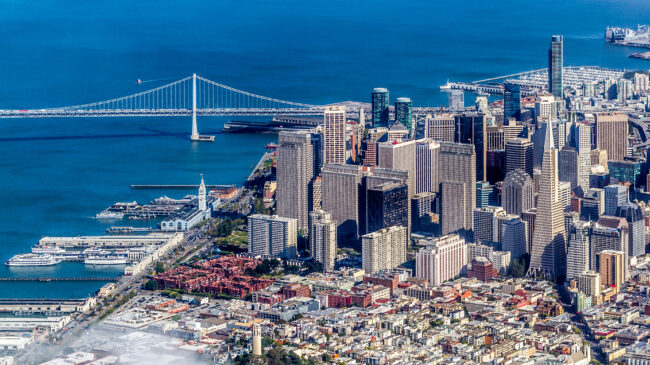During the flush financial times that preceded 2020, Bay Area transportation planners were looking forward to breaking ground on a new 1.3-mile subway connecting the Caltrain Station with the Salesforce Transit Center. This Downtown Railway Extension, or DTX, would allow commuters from the peninsula and ultimately intercity high-speed rail passengers to reach San Francisco’s financial district without changing trains or taking a long walk.
The project, including add-ons such as an underground walkway to Bay Area Rapid Transit’s (BART’s) Montgomery Station, was estimated to cost $6 billion in 2018. While most of the funding for the project had not been identified pre-COVID-19 pandemic, it was reasonable to think that the strong local economy could generate enough tax revenue to cover a large portion of the construction costs. Regional planners probably also thought a potential change in presidential administrations might bring federal funding to help make up the remaining balance.
But with COVID-19 shrinking the economy and reducing the region’s office use, local funding will be far more difficult to find by the time DTX is completed. Furthermore, it may attract far fewer riders than initially expected. As a result, it could be time for the region to scrap or scale back this initiative.
The 2010s saw a rapid growth of San Francisco’s downtown, as both startups and incumbent technology firms added office capacity. This trend reversed in 2020 due to the coronavirus pandemic and economic shutdowns.
Although many of the Bay Area’s tech firms have continued to thrive during the pandemic, social distancing requirements obliged them to embrace remote work, with some companies planning to allow most or all of their employees to continue working from home indefinitely.
In a sign of these shifts, Pinterest paid $89.5 million in August 2020 to exit its commitment to lease 490,000 square feet of yet-to-be-built San Francisco office space, suggesting that the company has sharply lowered its expectation of future office needs.
Meanwhile, ridership on transit services that would feed DTX has, as would be expected during the pandemic, fallen sharply. According to statistics compiled by the American Public Transit Association, Caltrain boardings were 75 percent lower in the second quarter of 2020, when parts of the Bay Area were largely shutdown, when compared to the same time period one year earlier.
Similarly, ridership on AC Transit, which serves the Salesforce Transit Center, was down 64 percent and the Bay Area Rapid Transit (BART) saw 85 percent fewer riders. Notably, due to a variety of factors, including security concerns, weekend service reductions, and other factors, BART ridership was already falling prior to the COVID-19 pandemic’s arrival, suggesting some of the declines in Bay Area transit utilization is not entirely attributable to the pandemic.
It remains to be seen how much ridership will rebound once the pandemic subsides. A recent BART analysis projected that ridership is expected to remain relatively low long after much of the public has been vaccinated for COVID-19. BART forecast its ridership to still be 25 percent to 56 percent lower than pre-pandemic levels in June 2022.
Over the long-term, fewer commuters would translate into less farebox revenue for existing systems as well as potential reductions in tax revenues that could be channeled toward DTX. San Francisco’s downtown has already witnessed a spate of restaurant and store closures, which are reducing available sales tax revenue. Fewer office workers and fewer residents could impact both commercial and residential real estate values and thereby constrain property tax revenues.
Although the most recent plans for DTX suggest a $6 billion capital cost and a seven-year construction timeline, experience with recent San Francisco infrastructure projects provides reasons to believe that the costs will rise.
The Central Subway, connecting Caltrain Station to Chinatown, is somewhat over-budget and seriously late. Construction on the new line commenced in 2010 with a planned completion date of 2018. Multiple delays have pushed back the start of service to 2022. Projected costs have risen slightly from $1.5 billion to $1.6 billion and could increase further if delays continue.
Other recent San Francisco transit projects that have failed to meet cost and/or timing expectations include the Van Ness Avenue Bus Rapid Transit system, the renovation of the Twin Peaks Tunnel, and the construction of the Salesforce Transit Center—the $2.2 billion facility that had to be shut down shortly after its grand opening when workers found a large crack in one of the steel beams supporting the structure.
Rather than take on an ambitious transit project with uncertain revenues, resources, costs and timelines, Bay Area planners should consider postponing or scaling back the downtown extension.
One lower cost option for getting peninsula commuters to downtown San Francisco without requiring them to change trains would involve using existing surface tracks running in the median of King Street and The Embarcadero. These tracks connect Caltrain Station to points relatively close to the Salesforce Transit Center and to the Embarcadero BART station. Currently, this route carries light rail trains operated by the San Francisco Municipal Transportation Agency. Substantial alterations would be needed to prepare this line to serve commuter and intercity trains, but these changes would likely be far less costly and disruptive than digging a new tunnel.
For transit planners, connecting downtown San Francisco to the regional rail network has understandably been a long-term goal. Many large cities have centrally located train stations that serve passengers from far and wide. But San Francisco is also a place in which transit infrastructure projects have become prohibitively expensive and the city’s future in a more distributed economy seems less certain than it did even nine months ago. Breaking ground on a new rail tunnel in this environment does not seem to a prudent step.

